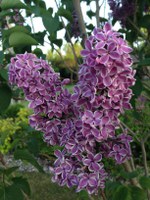Dakota Gardener: The Nuances of Pruning Spring-flowering Shrubs
(Click an image below to view a high-resolution image that can be downloaded)
By Esther McGinnis, Horticulturist
NDSU Extension
My former neighbor did not have a green thumb.
Shh! Don’t tell her I said that!
Although she was a woman of many talents, pruning shrubs was not one of them. We each had a lilac shrub adjacent to the property line. In mid-May, my shrub would burst forth in all of its lavender-colored glory. In contrast, my neighbor’s shrub would quietly leaf out and never bloom.
One year, she asked me why my lilac consistently bloomed each year and hers would not. I delicately responded that bad timing, combined with her pruning method, sheared off all of the newly formed flower buds before they could bloom.
Knowing when flower buds form is important information to have before pruning. Most spring-blooming shrubs have flower buds that were formed the previous year in late summer or fall. In spring, the flower buds on forsythia, bridal wreath spirea, viburnum and lilacs finish their development and put on a spectacular floral display. Major pruning between late summer and spring bloom would remove flower buds.
To muddy the waters, NDSU Extension states that the best time of year to prune spring- and summer-blooming shrubs is March or early April, while the shrubs are still dormant. The rationale is that pruning cuts heal faster if made just before spring growth commences. You may be rightly asking, “Won’t this cut off the flower buds on my lilac and forsythia?”
The answer depends upon the pruning method you use. I don’t blame my neighbor for not knowing the nuances of pruning. Most people use a gigantic set of hedge clippers and give their shrubs an all-over haircut. We call this shearing and this is not the proper technique.
Shearing stimulates a lot of dense growth on top of the shrub that can shade out the interior leaves. Repeated shearing will result in an unhealthy shrub.
Getting back to our original timing issue, shearing the shrub between late summer and spring may cut off the flower buds of spring-blooming shrubs.
A better method of spring pruning that also will conserve flower buds is to annually thin out a couple of the oldest and thickest stems all the way to the ground on mature deciduous shrubs. Also remove dead branches. Thinning opens the canopy to more sunlight and reinvigorates the plant.
This type of pruning only works for shrubs that have multiple stems emerging from the ground, such as lilac, forsythia and dogwood. Unlike shearing, only a limited number of stems are pruned, thereby conserving the flower buds on the unpruned stems.
If you forget to thin your spring-flowering shrub in March or April, the second best time to prune a limited number of stems is immediately after the shrub is done flowering.
If your multi-stemmed shrub is seriously overgrown, you can thin out a maximum of one-third of the oldest stems for three consecutive years to renew your shrub. The result will be vigorous growth and renewed flowering after the shrub has recovered. Regardless of bloom time, this type of drastic pruning should occur only during the dormant season in March or early April.
For more information about gardening, contact your local NDSU Extension agent. Find the Extension office for your county at https://www.ag.ndsu.edu/extension/directory/counties.
NDSU Agriculture Communication - March 2, 2021
Source: Esther McGinnis, 701-231-7971, esther.mcginnis@ndsu.edu
Editor: Ellen Crawford, 701-231-5391, ellen.crawford@ndsu.edu




